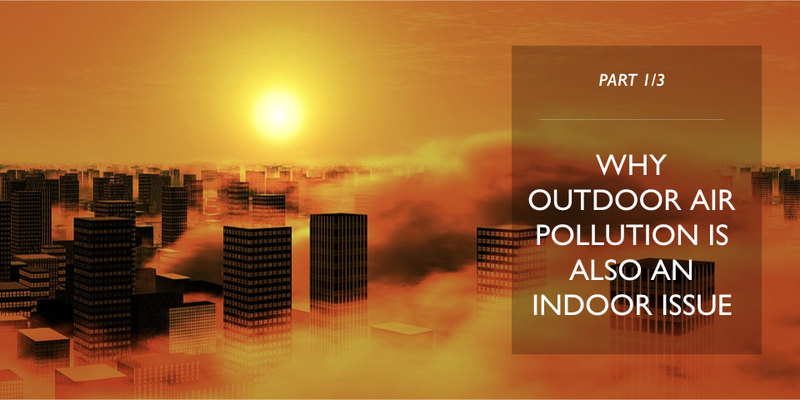Part 1/3: Why Outdoor Air Pollution is Also an Indoor Issue
Today, the impacts of the built environment on human health are of primary concern and focus. In addition to an emphasis on how buildings can save energy, water and resources, they are now required to positively impact the lives of occupants. At the core of this trend, lies the intricate topic of indoor air quality (IAQ). Few subjects rival the complexity involved in understanding IAQ and its impacts on human health. Requiring deep understanding and acumen to interpret areas such as chemistry, physics, toxicology, sensor hardware, software and testing methodologies. It comes as no surprise to hear that teams working towards improved IAQ are confused and overwhelmed.
Luckily, there are experts with empirical knowledge on IAQ that have been digging into the heart of the matter. It is with their collective knowledge that we, the stewards of the “green building” movement, are becoming more informed about how to address our IAQ concerns.
But, to speak intelligently about indoor air, we must first understand outdoor or ambient air and how evidence-based studies focusing on the pollutants in ambient air are helping to inform our decisions indoors.
Ambient air pollution, both urban and rural, is the direct cause of three million premature deaths worldwide each year. It is creating high burdens of disease from respiratory infection, cardiovascular diseases and lung cancer. Inhaling solid cooking fuels was historically at the root of noxious indoor air quality, but increasingly the health hazards of urban air pollution are concentrated in urban cores. Here stagnant air, vehicle exhaust, and coal-based industrial emissions combine to form a toxic airborne brew laden with tiny but lung-penetrating particulate matter. As awareness of the health fall-outs of poor air quality extend from outdoors to indoors, the known environmental risks also have moved beyond respiratory. Related illnesses include an array of neuro-generative diseases and neuro-behavioral functions. Current research continues to emerge demonstrating strong linkages between ambient air pollution and high levels of dementia, nearly doubling the likelihood among elderly females.[1] Additionally, Parkinson’s disease, autism, and most perniciously, premature births have been linked to the adverse effects of poor air quality.
Passive ventilation is a core principle of low-impact building design, but only where breathable outdoor air permits intake. Where it does not, fenestration and HVAC systems are insufficient barricades to outdoor PM 2.5 infiltration. The result is that our indoor spaces, which are presumed immune from the bad air, are double-loaded with contaminants originating both outdoors and in. Indeed, indoor air quality can easily register a higher level of harmful contaminants like volatile organic compounds, elevated CO2 and even indoor PM2.5 than outdoor air. With most Americans spending 90 percent of their lives indoors, pathways to substandard air quality are substantial. At certain threshold levels of exposure, air quality may even affect how we approach basic cognitive tasks like decision-making, focus, and information-usage. Harvard University researchers from the T.H. Chan School of Public Health pioneered two studies on the Impacts of Green Buildings on Cognitive Function—also known as the CogFx studies—to show how minimizing indoor toxicants actually improves cognitive performance. The same study methodologies are finding their way to other types of enclosed workspaces where cleaner air may yield clearer heads.
Studies like those conducted at Harvard reveal the invisible health-divide in the indoor air we breathe. With poor indoor air quality instigating debilitating physiological responses we never imagined and better-quality indoor air enhancing our cognitive performance. So how can we, the imaginers of healthier, sustainable communities, translate these findings to find solutions, tech-, data- and nature-based, that fix the problems?
One way to answer this question is by posing another, “What would Nature do?” The answer inevitably involves an overview of evolutionary history. Our ultimate resource for solving this massive problem and the very foundation for the design communities’ hottest trend, biomimicry and biomimetic design.
With 3.8 billion years at its disposal, nature has evolved and tested an inconceivable number of solutions for problems facing life on Earth. Many systems have failed; but some systems have stood the test of time. These systems are resilient and closed-loop. Humans have the advantage of learning from both the natural world, and our own intellectual tools. By studying natural systems and applying biomimetic strategies, we are afforded a quantum leap in the realm of engineering, and none too soon. It behooves our species to learn from nature; its cooperative, symbiotic relationships and develop healthier materials and environments in which to live. When natural systems are coupled with honest, human ingenuity, the most robust R&D department on Earth gets optimized by the most creative species to inhabit it.
NASA was an early pioneer studying nature for solutions to air quality issues; largely due to the fact that an orbiting space station is not the easiest place to send fresh air. In order to sustain an impossibly harsh environment like the International Space Station, it was crucial for NASA scientists to develop systems that could purify and regenerate an indoor environment. As a result, we have advanced air purifications strategies that deviate far beyond simply filtering out the ‘bad’ and disposing of toxic filters. While these solutions have existed for decades, it has taken a great deal of time for them to become mainstream due to a “business as usual” consumer-driven market; unprepared and often too reticent to pilot unorthodox technologies. Ironically, planned obsolescence is forcing our hand; our landfills are filling and our linear solutions are driving us to a ledge. We must create resilient and non-wasteful systems that manage our essential resources without frivolous material extraction and waste generation. Nature abhors waste.
We see the shift to this type of efficient and self-sustaining system with black water management, bioreactors, and bioremediation. All holistic solutions giving rise to the human-nature connection. This human-nature connection is reaching a climax as we pair computers with biological systems. We now have an unprecedented potential to transform the way we handle waste, pollution, and externalities.
Under these rules, data-driven, living-machines are the future. When we combine mechanical, biological, and electrical sub-systems into a multifunctional ‘organism’, we will have the capacity to accomplish things that no singular ‘appliance’ or singular human ever could. Of course, this technology and resulting healthy spaces living-machines generate, must be data driven, transparent, and accountable.
1 Women exposed to air heavily concentrated in P.M 2.5 were found to be at 81 percent greater risk of general cognitive decline and 92 percent of developing dementia than those breathing air at or below EPA levels of acceptable air quality standards. Translational Psychiatry (2017) 7, e1022; doi:10.1038/tp.2016.280
Published online 31 January 2017

